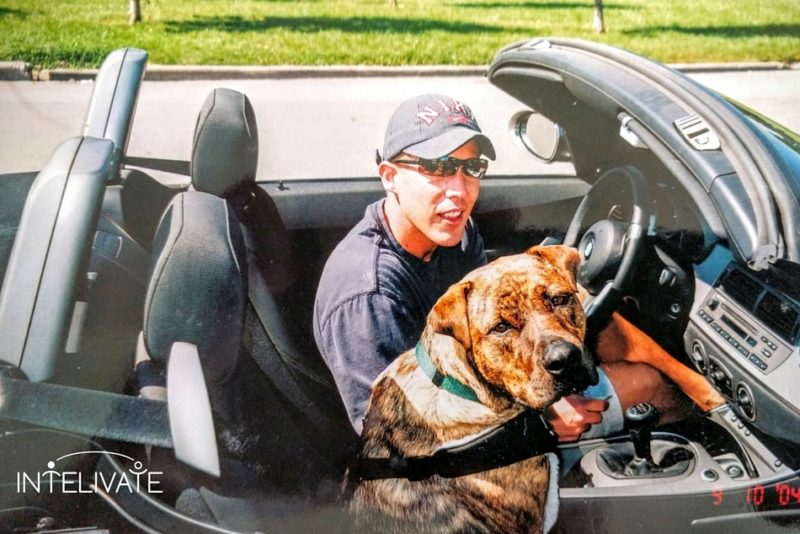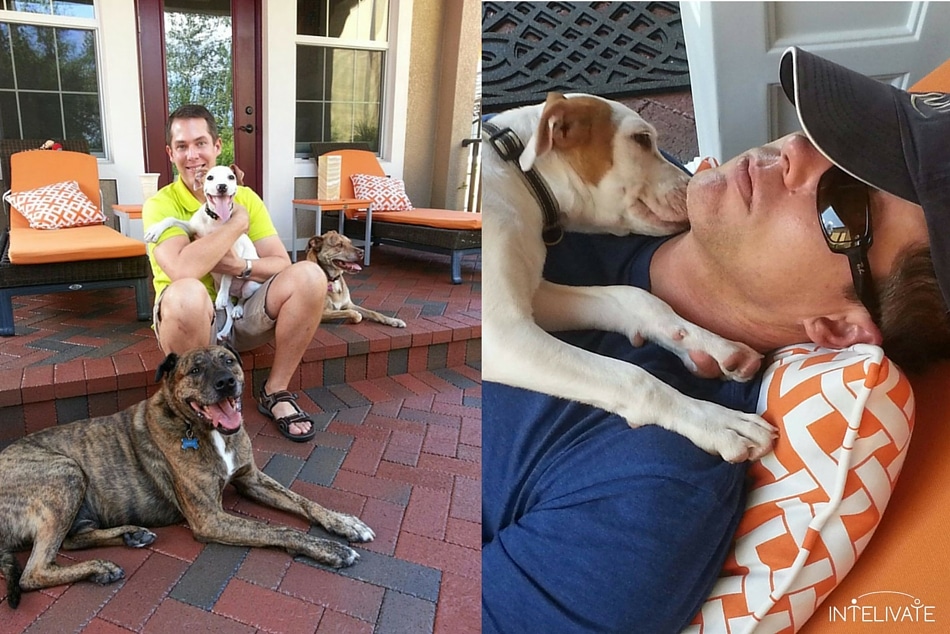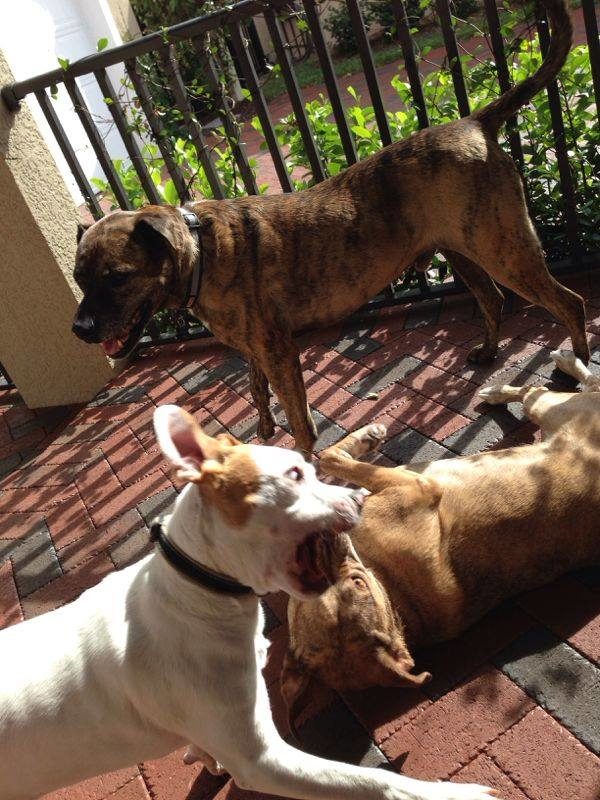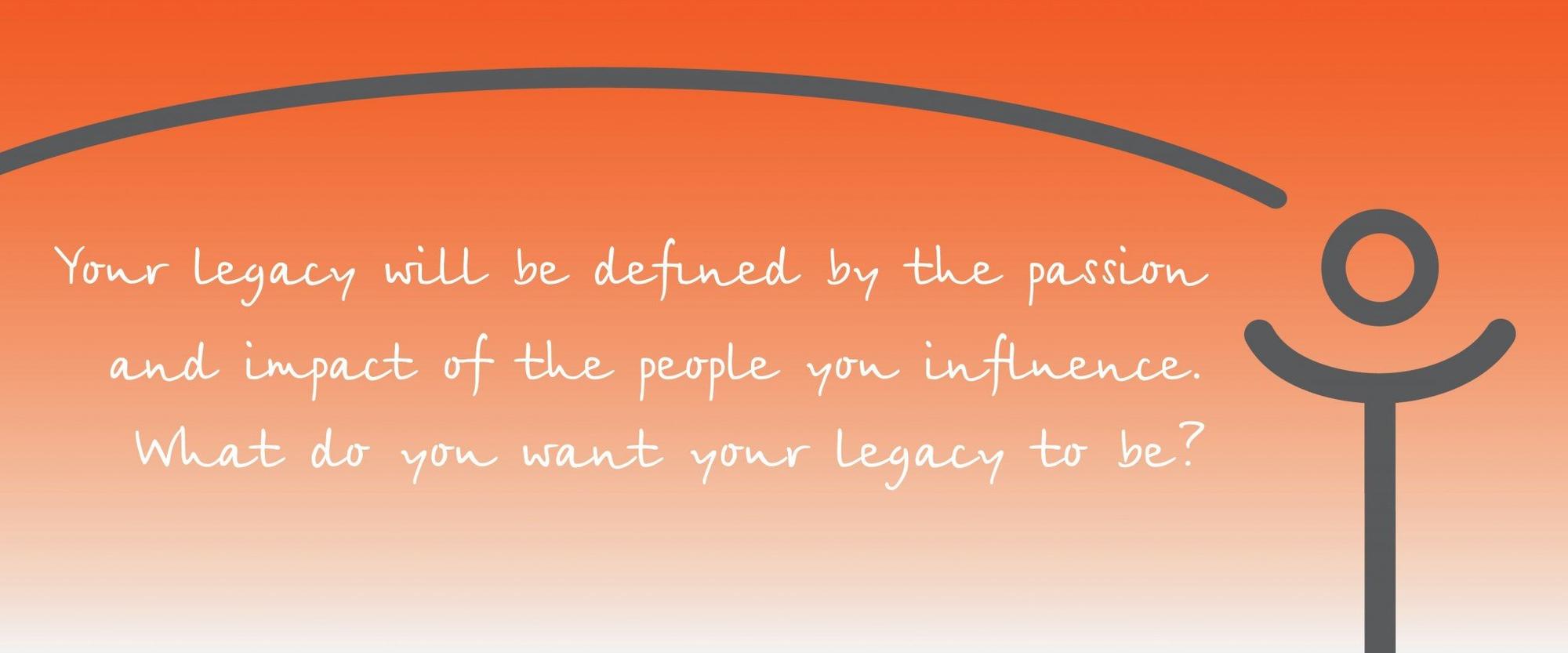More than 14 years ago, Kris Fannin met a rescue dog that has taught him some of the most effective leadership lessons of his career.
UPDATE: We are sad to report that Intelivate’s unofficial mascot, Marcus Fannin, passed away very peacefully at home. Kris Fannin documented their last day and some of the other lessons he learned from the experience.
More than 14 years ago I visited a shelter in Chicago to meet a young rescued pit bull. The rescue organization saved Marcus from the gas chamber (literally).
When I arrived, I was asked to go to the roof for a meet-and-greet. The volunteer told me Marcus was extremely shy, and she gave me some treats to entice him. As soon as I saw him, it was love at first sight. For me.
He could not stand me.

No matter what the volunteer did and no matter how many treats I hung in front of me, he would not come anywhere near me – not even to take a treat. She started packing the dog cookies up to bring him back.
What I asked shocked her.
When can I bring Marcus to his new home?
She thought I had immediately given up like every other visitor. If anything, his unwillingness to come to me made me adore him all the more.
It was going to be a challenge, and I love a challenge with a happy ending. She warned me that based on the breed and his shyness, I would need to be the leader and teach him a lot. What I did not know then is Marcus would teach me much more than I would him over the next 14 years.
As his time here starts to close to an end, I realized there are effective leadership lessons I learned from him and my other two crazy rescued dogs. Marcus’ effective leadership lessons and legacy will forever live in everything that old man has taught me over the years.
9. Listen to My Tail – Not My Growl
One of the first of many leadership lessons I learned from Marcus was the extreme power of body language.
Remember when Marcus would not take a treat? That means he is terrified. My gauge with his level of anxiety now is always the treat. If he turns his head away and keeps his mouth closed, I know his level of anxiety is through the roof.
You can see the power of body language in the video below.
Mercedes (the middle child) is being introduced to Maverick for the first time when he comes home from the rescue shelter. Watching their communication with nothing more than movement is fascinating.
The power of body language as – both in observation and execution – is critical to being an effective leader. I’ve learned to use my body language to communicate as often people will not hear the words I am saying, but they are sure to get the message I am sending through my body language.
As a leader, it is imperative to master the observation of body language in others. Yes, there are universal messages sent with some types of body language, but every individual is unique.
One of the first things I learn as a leader is the body language of each of my colleagues. It takes time, much engagement and commitment but helps prevent communication barriers.
It is the same approach I took with all my rescued dogs.
Mastering of body language is one of the most significant learnings I have received from Marcus, especially as he has gotten older, wiser and slower.

8. If You Can’t Eat It or Play With It, Pee On It and Walk Away
Marcus’ two favorite things in the world are to eat and play. If he tries and can’t play with or eat whatever ‘it’ is, he’ll pee on it and walk away. I do not suggest you do the former, but the latter is an essential lesson.
If ‘it’ or ‘he’ or ‘she’ doesn’t add value to you, don’t fight to keep ‘it’ or ‘him’ or ‘her’ in your life or your career. Walk away.
Don’t expend the energy investing in something or someone that overall does not add some significant value to your life. This is an effective leadership behavior that will keep you focused on the important people and things to get things done.

This is a way of getting rid of toxic relationships focus on those things and people that do add respective value. Otherwise, you end up neglecting those things and individuals if you are distracted by things you cannot eat or play.
7. Accept Me for Who I Am – Not Who You Want Me to Be
For the longest time, I tried to get Marcus to eliminate his shy demeanor. I remember getting rather frustrated at times and then he gave me a look (see #1 on the list). I got the look.
It was a look pleading for me to:
Please stop trying to make me into something I’m not.
I accepted early on that Marcus’ shyness was not going to change and learned to embrace and plan for it.
When others tell me I should work on that more with him, I just remind them that shy is what he is. It is nothing he wants to change and nothing I am going to work to change unless he wants it. Focusing only on those things you control and influence is a trait of effective leadership.
The most important person for you to accept and forgive is always you.

Discovery of the Core Issue
About three years ago, I found out that he was shy for a good reason. After breaking his ACL during play time with his siblings, the x rays revealed one of his hips was horrifically arthritic. His other hip was perfectly healthy. They determined his hip was broken at an early age without anyone healing it.
I now know why he took so long to trust me. He is smart and wise. He was willing to forgive but never forget so he didn’t repeat bad history.
To stay effective as a leader, I have to remember that just because I want something for someone, doesn’t mean they want it. Just because I think someone wants to grow in a certain way, doesn’t mean he or she wishes to develop in that way.
Communication and acceptance in leadership are essential. Determine priorities and focus on the mutually beneficial ones. Otherwise, you are not only wasting your efforts, but you are also likely losing the gift of growth and influence, which is a critical mark of any leader.
6. Time Away Rekindles Passion
I would spend the most frustrating amount of money on toys that these rescued dogs would fall in love with and play with for 30 minutes. After 30 minutes, if they had not destroyed it, they soon lost interest in it. Regardless of how far I tossed it, dangled it, or how much peanut butter I slathered on it, there was little sustainable interest.
Years ago and out of frustration, I took all the toys up before I was about to entertain as they were cluttering the room. As I picked each one up, the ears went up, the heads all tilted to the side, and curiosity quickly built throughout the house. They followed me EVERYWHERE as I picked up each of their toys, and I quickly became more curious.
At the end of the party, I brought the toys back out. You would have thought it was the first time they had ever experienced a toy.
Oh, the love and joy that occurred at that moment were just beautiful!

What I learned is if it is always accessible it becomes ordinary. Even the most extraordinary things become familiar once you reach a level of exposure. The power of missing something cannot be understated as it gives you an entirely new perspective on what you were taking for granted.
5. Leadership Lessons – Effective Leadership Means to Take Risk and Ask for Help
The video below says it all. Everything. Marcus was terrified of the pool. However, he WANTS that ball.
Marcus was taking a real risk, but at the same time asking for and accepting help.
As a leader, that can be tough just based on the nature of the role. Your leadership instinct is to assist not ask for help. Everyone is human – even you – the leader. The more you learn to ask and accept help, the more confident you will be in taking a risk. The more risk you successfully navigate, the more successful you become.
See the pattern here?
It starts with accepting help when you need it.
As a leader, don’t be too protective. I remember after Marcus had broken his ACL, I was terrified to let him play like he wanted. He began to hate me a little bit. Sure he was safe, but wasn’t happy because he could not do what he loved – play!
Make sure you are not squeezing the passion and confidence to take a risk from your colleagues. Balance protecting and independence. Leaders – your colleagues do not always want – or need – your protection.
4. First Impressions are Lasting and Often Inaccurate
I remember walking Marcus down the sidewalks in Chicago. Countless times, someone walking towards us would work to cross a busy street rather than go by Marcus. He looked ferocious; in reality, he was incredibly shy yet happy at that moment. He was much more scared of passing someone than anyone was of passing him – guaranteed.
We are human. We make first impressions – it is a part of what has allowed us to evolve and survive.
As leaders, we continuously assess our surroundings and make first impressions. Give yourself and others the opportunity to make actual impressions based on a series of engagements. Keep an open mind. It’s an invaluable leadership lesson.

I could not imagine the world if Marcus did not change his impression of me. I could not imagine a world of all the amazing and extraordinary people in my life that would not be here if I had not allowed the opportunity to change that first impression.
I cannot even fathom the number of people who were open to changing their first impression of me. Seriously, I cannot even imagine the number – everyone?
I am thankful for it, nonetheless.
3. Set The Example. A Grunt or Growl Might Be Enough.
Sometimes people get emotional, especially around their passions. It can be easy to react to it but set the example as the leader. Stay calm, be selective in what you say and how you react – and pay attention to body language.
The same holds true when you are emotional. Even though you may want to let it all out right then and there, a mere grunt and growl can make a world of difference. As a leader, you have a lot more power than that, but sometimes restraint is the most incredible act depending on the circumstances.
2. Structure and Routine Provide Calm
Part of your leadership function provides structure and routine even when it might seem not be wanted. The structure provides limits and routine provides for normalcy. Both are incredibly important especially if you are a leader that is looking to do anything innovative and requires risk.
Without structure, people either take a risk too far or not far enough. Without routine, there’s a feeling of unsettlement and lack of normalcy which can be both distracting and cause a ripple effect within an organization.
Structure, routine, and normalcy are especially important during the stages of change management.
Don’t go overboard in either. Build for natural fluidity and independence, but set the environment with a certain level of structure and routine. When these kiddos do not have both, they act out. You do not want the same with your colleagues and teams.
1. Goodbyes are Hard but Are Never Forever
Once the suitcase comes out to pack for a trip, Marcus pouts. Literally. He does not and won’t say goodbye. When I go down to give him a peck he turns his head and walks away. However, once I leave, he also immediately goes to the door to watch me once it has closed.

He has seen me go on hundreds of trips, and he knows I am going to return. He just hates the goodbye.
We all do.
Job and career transitions happen, and as you work your way through the organization and industry, goodbyes are necessary. However, goodbyes are never forever.
At Intelivate, we talk about leadership legacy. It is in the statement below.

Even though Marcus’ days are winding up on this earth, his legacy will forever live on. The leadership lessons he has taught me, I am sharing with you as I have shared with many others in the past.
Some of those life and leadership lessons are then passed from those people to people they influence.
The pattern continues infinitely.
Your Legacy Makes You Timeless
The same goes with YOUR leadership legacy.
Each time you impact the passion of someone, you have done something to build your leadership and legacy definition. I guarantee those people you influence will pass that effect onto someone else who in turn will do the same. The more you focus on passion and impact of the people you influence, the broader, deeper and more infinite your leadership legacy becomes.
The same holds true for a rescue dog that I met on a rooftop in Chicago. A rescue dog I would come to know as Marcus and who would thankfully reconsider his first impression of me.
In reality, Marcus has been a powerful and loving leader, impact, influence and just plain hero in my life over the last 12.5 years. His leadership legacy will live long past his bum hip – it will be infinite.
Passion, impact, and influence can come from the most unconventional places, beings, and even rescued dogs. Scared rescued dogs that taught me the most important life and leadership lessons yet.
Don’t forget to look around, be aware and be open to all the possibilities of their sources. You might surprise yourself with how much in our lives – even the most simple things – can inspire. If you – the leader – allow your mind, intellect, and soul to let all those potentially life-changing things into your being.
Now, I am going to go and give a hug to my hero.
I am hoping you do the same.
Enjoy simplicity.
Related Solutions to Help With Your Leadership & Business Development
> Leadership & Organizational Strategy Solutions
> Leadership Development Training
> “What is the most effective way to implement a leadership training program?” in FAQs
Kris Fannin
Kris Fannin is a passionate change agent in workforce transformation. For more than 25 years, he's had the privilege of partnering with dozens of client organizations and leading hundreds of teams to become powerful influencers.
"Your legacy will be defined by the passion and impact of the people you influence. What do you want your legacy to be?"



